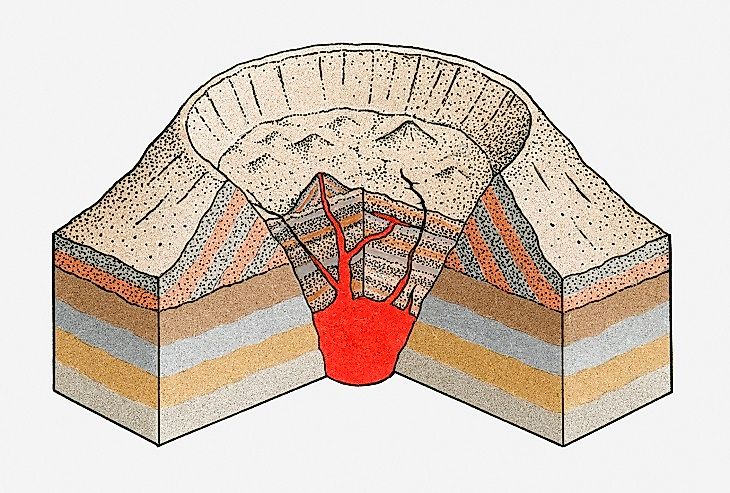What Is A Volcanic Caldera?

What is a Volcanic Caldera?
When a volcano erupts explosively, without any structural support below, its walls often collapse inwardly. This has the effect of forming a bowl- or cauldron-shaped caldera. The world caldera has been derived from the Spanish word caldera, meaning “cooking pot”, and was first used in geological vocabulary lexicon by Leopold von Buch, a German geologist. Calderas are different from craters in that the former is generated by a caving-in of a volcano’s walls, while the latter is formed by an outward explosion of rocks and other volcanic matter during a volcanic eruption. Volcanic calderas are much more expansive than a crater, and can be over 100 kilometers wide, while craters will typically have a maximum diameter of but 1 kilometer. The formation of calderas also can have a more devastating impact on the environment than a crater, as the former permanently alters the topography and environment of the surrounding land due to its larger size.
Types of Calderas
Resurgent Calderas: The Toba Caldera in Sumatra, Indonesia, is an example of a resurgent caldera. Formed by a massive volcanic eruption about 74,000 years ago, the caldera is about 100 kilometers long, 29 kilometers wide, and 508 meters deep. Resurgent calderas are formed by the worst form of volcanic disasters where not just a single volcano, but multiple magma chambers, spread over a large area, all collapse in unison, thus generating a caldera that is anywhere from between 15 and 100 kilometers wide. The Yellowstone Caldera of Wyoming, in the U.S.A’s Yellowstone National Park, is also an example of a resurgent caldera. Resurgent caldera formation has not been known to happen in recent times.
Crater Lake Calderas: Powerful volcanic eruptions from stratovolcanoes, spewing out huge volumes of volcanic rocks, lava, and ash in what are known as "plinian eruptions", often result in the formation of large volcanic caldera that gradually accumulates rain and snow to form huge lakes. Two examples of crater lake calderas are the Crater Lake in the U.S. state of Oregon (formed by eruption of Mount Mazama), the deepest lake in the United States, and the Deception Island of Antarctica, which was formed by an eruption of the active Deception volcano during a violent eruption about 10,000 years back.
Shield Volcano Calderas: Unlike the single massive explosions triggering a caldera formation in the case of crater lake calderas, shield volcano calderas are formed by periodic episodes of volcanic eruptions from shield volcanoes, caving in land in gradual stages, and creating terraced depressions in the process, rather than a cauldron-like depression. Thus, the shield volcano calderas are much smaller in diameter (usually less than 5 kilometers wide) than crater lake calderas and resurgent calderas. The Hawaiian Islands and the Galapagos Islands house several shield volcano calderas.
Extraterrestrial calderas
Volcanic activity is not just limited to our planet of Earth, and can be seen in many other planets of the solar system, and the moons of some planets also experience volcanism and consequent formation of calderas as well. Calderas with an average diameter of about 68 kilometers have been detected in Venus, while calderas with an average diameter of 40 kilometers have been detected in Io, a moon of the planet Jupiter. The largest volcano in the solar system, the Olympus Mons in planet Mars, has six nested calderas at its summit.











